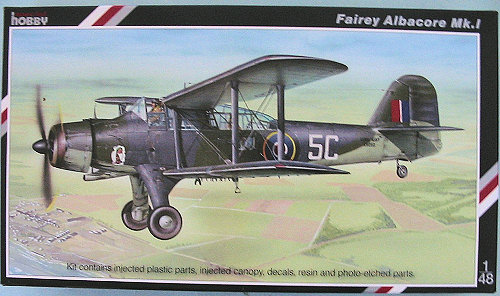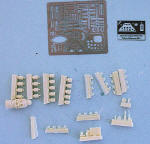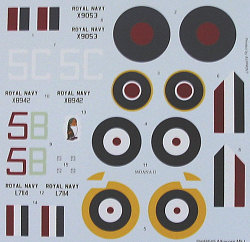
| KIT: | Special Hobby 1/48 Albacore I |
| KIT #: | 48045 |
| PRICE: | £25.96 |
| DECALS: | Three options |
| REVIEWER: | Tom Cleaver |
| NOTES: | Short run with resin and photo etched parts |

| HISTORY |
The Fairey Albacore was designed by Marcel Lobelle in response to Admiralty Specification S.41/36 for a Torpedo-Bomber-Reconnaissance aircraft to replace the Swordfish. The prototype for a 3-seat biplane with a fully-enclosed cockpit flew on December 12, 1938, powered by a 1,065 hp Taurus II. Armament was a fixed forward-firing 0.303-in machine gun and one or two similar guns in the rear cockpit, with an 18-inch, 1,600-pound torpedo under the fuselage, or four 500-pound bombs under the wings and a top speed of 161 m.p.h..
The Albacore was obsolete at the time of its entry into service in 1940, and lacked the qualities that made the Swordfish successful. 800 Albacores were produced between 1940-43. Not only did the Albacore not replace the Swordfish, but when it was taken out of service in late 1943, the Swordfish remained in first-line service until the end of the war.
The first squadron to operate the Albacore was 826 Squadron, which had been specially formed for this purpose in March, 1940. The Albacore went aboard carriers in 1941,and there were eventually 15 Fleet Air Arm squadrons equipped with the plane.
The Albacore saw most of its action in the Mediterranean, where the aircraft participated in the Battle of Cape Matapan. Shore-based squadron flew night bombing missions in support of the Battle of El Alamein, while carrier-based squadrons took part in Operation Torch and supported the landings at Sicily and Salerno. 828 Squadron, which was taken off of HMS Victorious after the carrier made a run to Malta to deliver fighters, operated from Hal-Far, Malta, from September 1941 to July 1943 throughout the blitz. The Squadron performed night bombing attacks against Sicily and southern Italy, and anti-shipping strikes at night against Axis convoys throughout the central Mediterranean.
Outside of the Mediterranean theatre, the Albacore is best known for its participation in the Fleet Air Arm strikes on Petsamo and Kirkenes, Norway. Following the German invasion of the Soviet Union on 22 June 1941, Winston Churchill ordered the strikes in an effort to give practical support to the Soviets by hitting German lines of communication in northern Norway and Finland. Operation "EF" involved sending the high-speed minelayer, HMS Adventure, to Archangel with a large load of mines, while the air groups of HMS Furious and HMS Victorious struck Petsamo and Kirkenes respectively on July 30, 1941. These two ports were used by the Gebirgs Korps Norge, and it was believed German shipping would be present.
The mission was intended as a surprise attack, which proved impossible in the midnight sun conditions in the high Arctic. The element of surprise was lost when the Fleet was sighted by a shadowing Do-18 shortly before the strike was launched. Furious launched 9 Albacores of 817 Squadron and three escort Fulmars of 801 Squadron in one flight and 9 Swordfish of 812 Squadron escorted by three Fulmars of 801 in a second flight against Petsamo. Arriving at the target, the harbor was nearly empty and flak was heavy. The Albacores claimed the sinking of one small steamer while the Swordfish destroyed several jetties. One Albacore and two Fulmars were lost to enemy fire.
HMS Victorious launched 12 Albacores from 827 Squadron, eight Albacores from 828 Squadron, and nine Fulmars from 809 Squadron, in two flights to hit Kirkenes. Fully alerted, the Luftwaffe was waiting at Kirkenes with a mixed force of Bf-109s and Bf-110s, and the strike was a disaster. The attackers claimed to have sunk one 2,000 ton steamer, set another afire, with minor damage ashore. The escorting Fulmars claimed two Bf-109s and one Bf-110 destroyed, but losses were severe, with 11 Albacores and two Fulmars shot down and eight other Albacores damaged. In the face of these losses, 827 Squadron ceased to exist.
One Albacore claimed to have shot down a Ju-87 at Kirkenes, which if true made it the only kill ever claimed by an Albacore. The Stuka was part of a flight returning to Kirkenes from a bombing raid against Murmansk and became involved in combat against the Albacores accidentally.
The Barracuda began to replace the Albacore in 1943,with the last Fleet Air Arm squadron - 841 - being decommissioned in December 1943. The RCAF took over the Albacores of 841 and operated them during the Normandy invasion on anti-submarine and anti E-boat patrols.
The Albacore as an airplane was the victim of outdated thinking on the part of the Royal Navy as to what was going to be needed for carrier-based aircraft in the war everyone knew was coming. It was the last biplane ordered for the Fleet Air Arm. Despite its manifest obsolescence, the Albacore performed well under difficult circumstances. Its operation from Malta had a major impact on the war in North Africa.
| THE KIT |
 MPM
has released a 1/72 kit of the Albacore several years ago. This kit by Special
Hobby - a part of the MPM empire - is the first 1/48 kit in injection-molded
plastic. I believe there was at least one vacuformed kit released some 15-20
years ago.
MPM
has released a 1/72 kit of the Albacore several years ago. This kit by Special
Hobby - a part of the MPM empire - is the first 1/48 kit in injection-molded
plastic. I believe there was at least one vacuformed kit released some 15-20
years ago.
Like
many short run kits, the Albacore is a "multimedia" kit with four grey plastic
injected styrene sprues and one in clear plastic, which, while thick is very
clear, a bag of small resin parts including a well-detailed engine, a photo-etch
fret that includes instrument panels and seat belts, and a small acetate film
for the instrument panel. The quality of the molding is outstanding, with
lightly engraved panel lines and very realistic-looking “fabric effect” that
does not have any of the hills and valleys other companies still seem to think
are de rigeur for fabric-covered aircraft. The decal sheet includes
three aircraft, including one from 828 Squadron when
engine, a photo-etch
fret that includes instrument panels and seat belts, and a small acetate film
for the instrument panel. The quality of the molding is outstanding, with
lightly engraved panel lines and very realistic-looking “fabric effect” that
does not have any of the hills and valleys other companies still seem to think
are de rigeur for fabric-covered aircraft. The decal sheet includes
three aircraft, including one from 828 Squadron when
 based on Malta. There is
sufficient interior detail to look good when complete. The canopy may be thick
but it is clear enough that with a coat of Future the interior should be easily
visible.
based on Malta. There is
sufficient interior detail to look good when complete. The canopy may be thick
but it is clear enough that with a coat of Future the interior should be easily
visible.
The lower wings are supposed to butt-join. I suggest a modeler make some attachment spars with plastic rod. Fortunately, the large upper wing is one piece, so the dihedral of both wings will be set when they are joined with the interplane struts.
There is no ordnance provided. Those modelers who purchased the Trumpeter Wellington and didn’t load the bomb bay will have an adequate supply of 500-lb and 250-lb RAF bombs to load up the model when complete. Do remember, it carried a maximum 2,000 pounds of bombs or a torpedo, never both. I intend to use the very good torpedo that was provided by Trumpeter in their Wyvern kit to arm my model as a night strike aircraft of 828 Squadron.
| CONCLUSIONS |
If you, like me, are a fan of the aircraft flown by the Fleet Air Arm during the Second World War, this kit of the Albacore is a must-have. I know I have wanted one in my collection for a good 20 years. This kit looks to have everything necessary to create a good-looking and accurate model, one that will look good on the shelf sitting next to the Tamiya Swordfish. With the coming release of the Fulmar later this month and the Skua in March, Special Hobby will have created kits of all the FAA carrier aircraft of the war. Highly recommended.
Thanks to Hannant’s for the review copy. Get yours at www.hannants.co.uk
If you would like your product reviewed fairly and quickly by a site that has nearly 350,000 visitors a month, please contact me or see other details in the Note to Contributors.